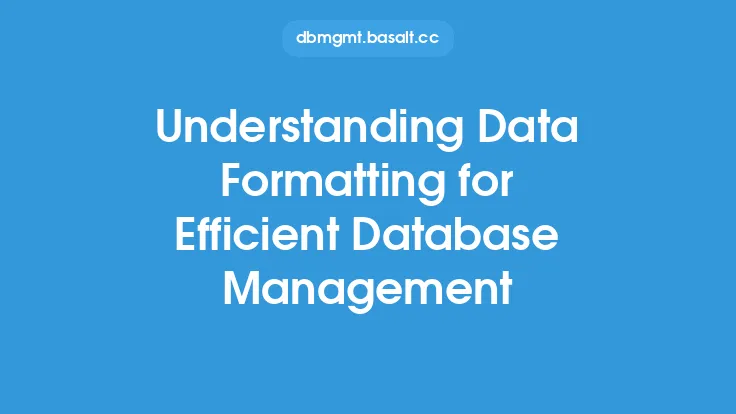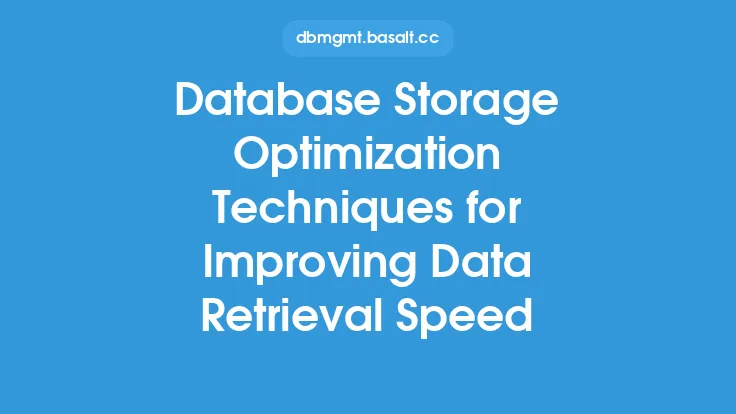Database indexing is a crucial aspect of data management that enables efficient data retrieval and manipulation. Indexing techniques play a vital role in optimizing database performance, as they facilitate quick location and access to specific data. In this article, we will delve into the various database indexing techniques that can be employed to improve data management.
Introduction to Indexing Techniques
Indexing techniques are methods used to create and manage indexes, which are data structures that improve the speed of data retrieval operations. Indexes can be created on one or more columns of a table, and they can be used to speed up various database operations, such as SELECT, INSERT, UPDATE, and DELETE. There are several indexing techniques, including B-tree indexing, hash indexing, and bitmap indexing, each with its own strengths and weaknesses.
B-Tree Indexing
B-tree indexing is a popular indexing technique that uses a self-balancing search tree to store index keys. B-trees are designed to keep data sorted and allow for efficient insertion, deletion, and search operations. They are particularly useful for range queries, as they enable the database to quickly locate a range of values. B-trees are also suitable for indexing large datasets, as they can handle a large number of index keys.
Hash Indexing
Hash indexing is another indexing technique that uses a hash function to map index keys to a specific location in an index. Hash indexes are designed for equality searches, where the database needs to quickly locate a specific value. They are particularly useful for queries that use the "=" operator, as they enable the database to quickly locate the required data. However, hash indexes can be less effective for range queries, as they require the database to scan the entire index.
Bitmap Indexing
Bitmap indexing is a technique that uses a bitmap to represent the index keys. Bitmap indexes are designed for columns with a small number of distinct values, such as a column that contains only 0s and 1s. They are particularly useful for queries that use the "=" or "IN" operators, as they enable the database to quickly locate the required data. Bitmap indexes are also suitable for indexing large datasets, as they require minimal storage space.
Composite Indexing
Composite indexing is a technique that involves creating an index on multiple columns of a table. Composite indexes are designed to speed up queries that use multiple columns in the WHERE clause. They are particularly useful for queries that use a combination of columns, such as a query that uses both the "name" and "age" columns. Composite indexes can be created using any of the indexing techniques mentioned above, including B-tree, hash, and bitmap indexing.
Function-Based Indexing
Function-based indexing is a technique that involves creating an index on a function or expression that is applied to one or more columns of a table. Function-based indexes are designed to speed up queries that use functions or expressions in the WHERE clause. They are particularly useful for queries that use aggregate functions, such as SUM or AVG, or for queries that use string functions, such as UPPER or LOWER.
Index Maintenance
Index maintenance is an essential aspect of database indexing, as it ensures that the indexes remain effective and efficient. Index maintenance involves tasks such as rebuilding indexes, reorganizing indexes, and updating index statistics. Rebuilding indexes involves recreating the index from scratch, which can help to improve query performance. Reorganizing indexes involves rearranging the index keys to improve query performance. Updating index statistics involves updating the database's statistics about the index, which can help the database to optimize query execution.
Best Practices for Indexing
There are several best practices that can be followed to ensure effective indexing. These include creating indexes on columns that are used frequently in queries, avoiding indexes on columns with a large number of null values, and using composite indexes to speed up queries that use multiple columns. Additionally, it is essential to monitor index performance and adjust indexing strategies as needed. This can involve using tools such as index tuning advisors or query analyzers to identify indexing opportunities and optimize query execution.
Conclusion
In conclusion, database indexing techniques play a vital role in optimizing database performance. By understanding the various indexing techniques, including B-tree indexing, hash indexing, and bitmap indexing, database administrators can create effective indexing strategies that improve data retrieval and manipulation. Additionally, by following best practices for indexing and maintaining indexes regularly, database administrators can ensure that their indexes remain effective and efficient. By leveraging these techniques and best practices, organizations can improve data management, reduce query execution times, and enhance overall database performance.





